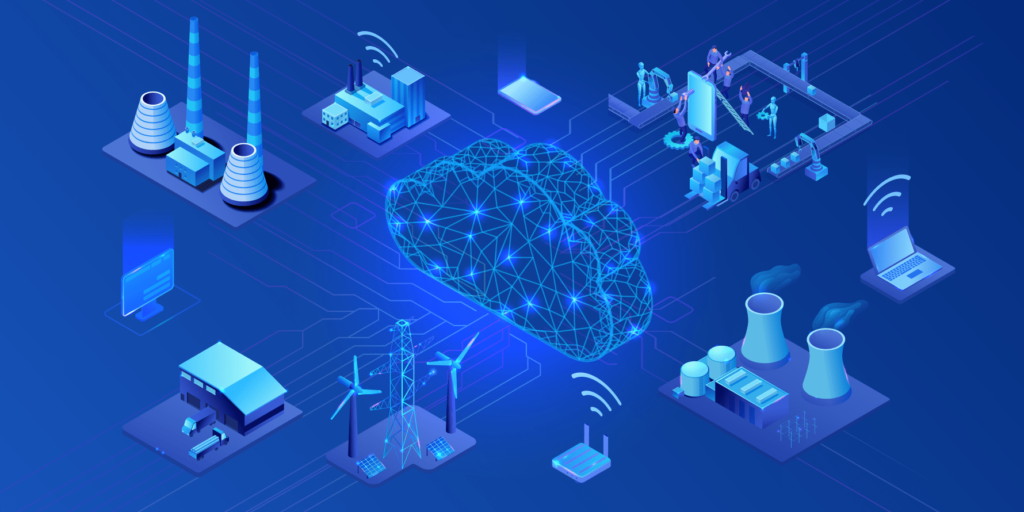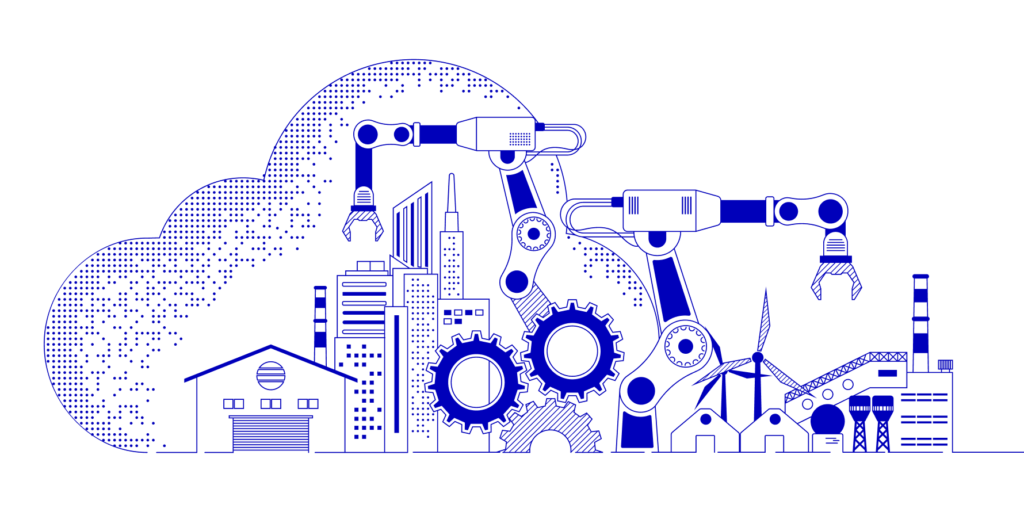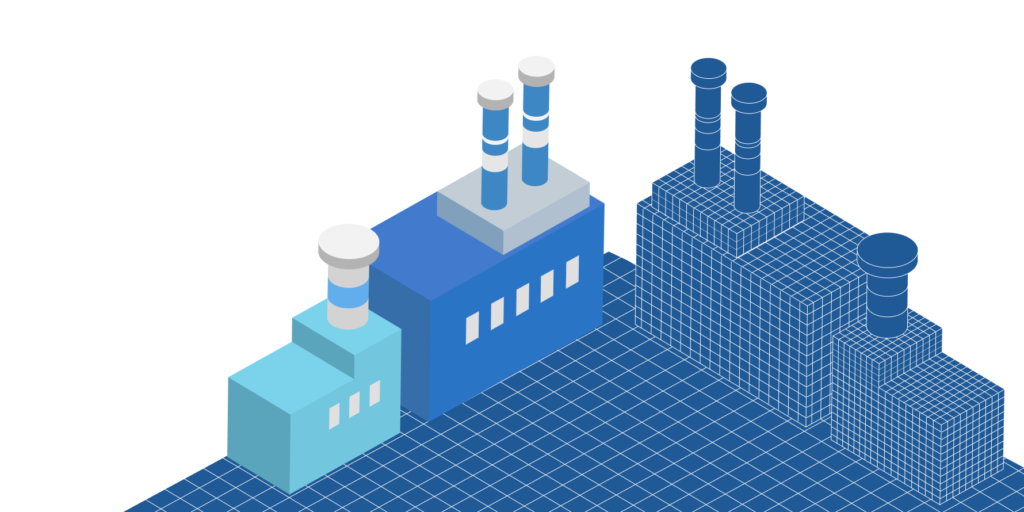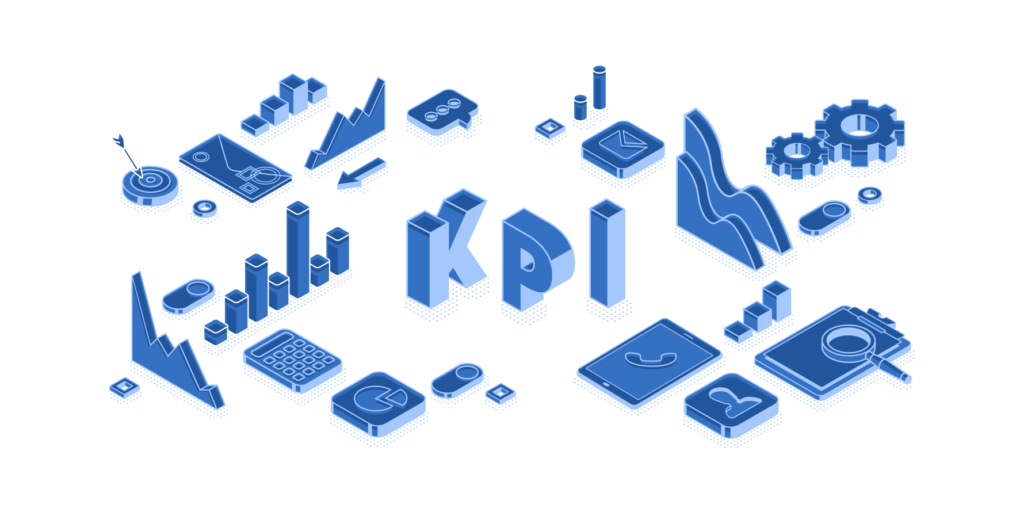Table of Contents
The Internet of Things has become one of the core technologies behind the digital transformation of a number of industries. According to Exploding Topics, the IoT market is expected to reach $1 trillion by 2024 and its CAGR for the period of 2023-2030 is expected to be 12.7%. As for the IoT in manufacturing, it is one of the biggest segments among all IoT projects and more and more businesses within the industry are adopting this technology.
So what exactly is IoT in manufacturing and in what ways does it help production facilities ? Without further ado, let’s get started.

The growth of IoT and its impact on manufacturing
In order to fully understand the impact of IoT on the manufacturing industry, let’s first look at some general statistics:
- There are approximately 15 billion connected devices globally;
- In 2023, the IoT market is worth approximately $800 billion;
- By 2030, we might expect 500 billion devices to be connected to the Internet.
The reason for such popularity is simple: IoT offers businesses new opportunities and valuable insights into their daily operations through 24/7 collection of information. But what does it have to do with manufacturing?
For quite a while, the manufacturing industry has been hesitant about adopting technology. There is a great 2023 report by L2L, which states that 42% of respondents (manufacturing leaders) haven’t started digital transformation and two-thirds of respondents believe that their competitors are ahead of them in terms of digitization.
However, there is also a great number of businesses who start recognizing the value that digitization and IoT adoption bring. Today, there are many exciting examples of using IoT for manufacturing. The popularity and value of the technology resulted in a new term – Industrial Internet of Things (IIoT).
Industrial Internet of Things explained
TechTarget defines IIoT as the use of smart devices to enhance and improve manufacturing processes. Cisco adds that Industrial Internet of Things allows businesses to derive valuable data from their operations. Hence, IIoT (we can also call it the manufacturing IoT) is aimed at helping manufacturers optimize their operations through real-time data collection and its efficient processing.
Industrial Internet of Things can be thought of as a subcategory of IoT, aimed specifically at supply chain and manufacturing. Whereas the Internet of Things is a more general concept and has a more customer-centric approach.
- Smart manufacturing IoT devices for data collection and tracking;
- Cloud computer systems for data storage and processing;
- Data analytics software for post-collection data analysis;
- Skilled specialists who will help an organization make data-driven decisions based on the collected data and gained insights.
Note though that these components are the same for the Internet of Things in general, so the only difference here would be the type of smart devices. In IIoT, it can be digital equipment or plants tools, while in IoT it can be wearables like a well-known Mi Smart Band.
All in all, the main thing to remember here is that Industrial Internet of Things significantly aids the manufacturing industry in making smarter, data-driven decisions and improving efficiency of operations. Now let’s see the core areas of IoT manufacturing.
The main areas of impact of IoT solutions for manufacturing
If we say “the IIoT impacts manufacturing”, that would sound too generic. There are many levels of operation in an average manufacturing business, and different areas require different data and approaches. Below, we explain the three main areas of manufacturing and the ways IIoT impacts each.

Shop floor
In manufacturing, the shop floor is a production area of a facility. The main activities that take place there usually include:
- Tracking potential issues in the production process and fixing them;
- Workforce scheduling;
- Alignment of the production jobs efficiently.
Even the smallest mistake in the production process can lead to a whole batch being cancelled or order picking delayed (not to mention the negative impact on customer service). Hence, the use of advanced technologies on the shop floor can greatly reduce the number of errors, increase safety, and enable more accurate monitoring of processes. Hence, the use of IIoT on the shop floor can help with the following:
- Real-time updates for tracking the working conditions of workers and their safety;
- Predictive maintenance for the equipment and timely identification of any issues;
- Assistance in the production planning due to monitoring of the production line.
As you can see, these improvements can not only improve and speed up the production process but contribute to better working conditions and help eliminate potential risks for workers.
Field operations
The next area of manufacturing is field production, which refers to various activities “in the field”, aka outside the traditional office/facility. Examples are property management, construction, or inventory control. Here, IIoT can help with the following:
- Fleet performance monitoring;
- Virtual equipment monitoring;
- Reduced response time to service calls.
By timely eliminating issues with equipment and assets and by always knowing the condition and state of the equipment, manufacturers are able to provide better customer service and gain better control over their assets and their management.
Supply chain
Supply chain refers to all operations related to the creation of products/services and their shipping to end users. There are lots of logistics and product management processes involved and it’s important to maintain all segments of the supply chain well-managed and optimized.
So what are the benefits of IIoT in this case? Here are a few examples:
- Monitoring of goods transportation (monitoring of temperature, humidity, etc.);
- Inventory and warehouse management and better resource allocation;
- Better control of storage conditions and their timely adjustment;
- Effective fleet management.
Third-party and remote operators
Finally, there are always some third-party organizations that you engage with (or you might simply distribute your business across various locations). To maintain a holistic view of the whole manufacturing process and timely react to any issues, happening at a remote location, businesses use IIoT. A few examples of its use cases are:
- Monitoring of processes via a centralized platform;
- Real-time notifications upon any issues;
- Transparent and effective data sharing.
The core benefits of IoT in Manufacturing
We’ve briefly discussed how IIoT helps throughout all areas of manufacturing. Now, let’s get more specific and take a look at the main benefits of using IoT in manufacturing industry in detail.
Increased efficiency of operations
One of the biggest benefits of IoT in manufacturing is automation of processes and, as a result, the increased efficiency of operations. Since IIoT is all about collecting real-time data, the system can independently start certain actions if triggered by the collected information. Say, if the temperature in your warehouse drops to a level below the required one, the system will receive this information and might be able to automatically turn on the heating. And this is just one example. As RPA (robotic process automation) experts say, everything can be automated – so you really just need to define the processes that will benefit from automation and apply IIoT and automation to them.
In addition, IIoT enables you to remotely monitor and control your operations, which saves your employees a great deal of time since they don’t have to be physically present to make any needed adjustments or decisions. And finally, IIoT (alongside machine learning) is the biggest driving force behind predictive maintenance. So if you are able to prevent equipment failures and immediately fix the issues, it will have a big and positive impact on your ROI in the future. This is because you won’t have to spend tremendous amounts of money on repair and will be able to avoid downtimes by timely bringing your equipment back to life.
Short time to market
As a result of increased efficiency, IIoT enables shorter time to market for manufacturers, and here is how:
- The goods are produced faster due to automation and optimization of the production process;
- The issues are resolved either before they occur or immediately after, meaning, they don’t make a big negative impact on the production;
- The decision-making is accurate and based on the real-time, relevant data;
- Communication and interaction with all involved parties is faster and more transparent;
- The number of unexpected issues drops due to predictive maintenance.
Increased accuracy and fewer errors
A human error is a significant factor to consider when you try calculating risks or estimating a certain project. It is an error that is not intended by the actor and that may happen due to various reasons, but most often due to a lack of attention. However, human errors are the once causing the most significant consequences, especially in dangerous fields like nuclear power. In manufacturing, human errors are also a frequent case and they impact not only the production process but also the cybersecurity of an organization.
This is where IIoT steps in and helps reduce the number of potential errors through automation. A machine cannot be inattentive by default and hence, won’t let a single error slip. As well, a machine is capable of scanning through massive data sets much faster and more efficiently than a human and hence, it can instantly detect any suspicious activity (in case of cybersecurity).
Increased safety
Workplace safety is a major issue that needs to be addressed on all levels, from workers on the shop floor to the ones working on distribution. To minimize and prevent potential accidents, organizations can effectively use IoT in factories.
Due to 24/7 collection of data by smart sensors, manufacturers can immediately learn about potential threats or an accident that’s happening and take corresponding actions. In addition to real-time notifications on potential threats, smart sensors can also educate and train employees on safe work practices and notify them in case anything has to be corrected.
Reduced operational costs
One of the biggest and most tangible benefits of digitization for any business is reduction of costs. So how does IIoT help manufacturers in this regard?
The use of Industrial Internet of Things helps with:
- Better allocation of resources and workforce;
- Predictive maintenance and as a result, mitigation of massive equipment failures;
- Better understanding of the production process and opportunities for optimization;
- Remote monitoring and hence, better management of equipment and processes.
All these things lead to lower costs since you will know exactly what is happening at the facility at any given time. You will therefore be able to avoid unnecessary costs (i.e., repeated and/or inefficient processes, too many resources for a single task, etc.) and at the same time, will know what specific areas call for your attention.
Main IoT use cases in manufacturing
Though we’ve briefly discussed the ways the Internet of Things is deployed in manufacturing, we’d now like to focus on specific IoT use cases that are considered the staples of IIoT. Remember though, that while all of them are great, every organization will have a specific use case for IoT, which will depend on its business objectives, needs, and technical challenges.
Digital twins

A digital twin is a digital copy of a physical object (i.e., a manufacturing facility) that fully replicates all processes that happen with this object. The main goal behind the creation of a digital twin is to monitor and study the object, as well as to set up various scenarios to see how certain changes will impact the object and its processes. For example, you want to expand your facility and properly allocate all machinery and resources. With a digital twin, you can easily map out the placement of your assets and check that the new space complies with safety regulations. Also note that there are various types of digital twins:
- Digital twin prototype: created before the physical object is built and is used to test the future object’s behavior and to evaluate possible risks;
- Digital twin instance: created after the physical object is built and is used to run various scenarios and tests before applying changes to the physical object;
- Digital twin aggregate: is also created after the physical object is built and is used to collect information and to monitor the object’s parameters and capabilities.
So what does the Internet of Things have to do with digital twinning? The thing is, the creation of an accurate digital twin is impossible without knowing the precise characteristics of a physical object and without syncing the parameters of physical and digital objects. The IoT technology lies at the heart of digital twinning as it allows organizations to collect real-time accurate information about a physical object and immediately learn about any changes in its parameters.
Predictive maintenance
Another example of IoT use cases in manufacturing is predictive maintenance. Predictive maintenance is aimed at timely identifying any warning signals with the equipment and eliminating them before they transform into an issue. And since the repair costs can be massive, manufacturers are obviously interested in ways to cut down these costs and maintain the equipment’s proper performance for as long as possible. Also, don’t forget about the cost of downtime which falls into the category of unplanned expenses.
The Internet of Things allow 24/7 monitoring of the equipment status and instantly notifies you in case anything goes wrong or calls for your attention. The technology helps manufacturers stay aware of the status of their assets, calculate possible repair costs beforehand, and ensure maximal efficiency of machinery.
Inventory management
In traditional inventory management, the process of monitoring and managing assets is often manual and time-consuming, which leads to inaccurate data, surplus or stockouts, and extra costs. A digital approach to inventory management, on the other hand, helps eliminate these issues and here is how.
The use of IoT in inventory management includes the use of sensors to collect the data (i.e., temperature, humidity) and RFID tags for easy item tracking and identification. With the help of these devices, manufacturers can:
- Enhance the visibility of inventory by always knowing what exactly is present in the inventory at the moment and in what amounts;
- Collect accurate, real-time information on both stored items and the state of the inventory;
- Better plan demand and avoid stockouts/surpluses by always knowing the amount of items in the inventory;
- Improve efficiency through elimination of manual processes (i.e., manual search for a certain item) and improved visibility.
Remote control
One more great example of IoT solutions in manufacturing is remote control of machinery and assets through smart devices. Even if your facilities are distributed across various locations, the collected information is all stored in a centralized hub and every approved user has access to it. In this way, it becomes easier to compare the production lines across various facilities, control the flow of assets and resources, and even fix certain issues via a virtual network.
Needless to say, an option to remotely control your equipment and resources greatly saves time, helps streamline your operations, and adds transparency to asset monitoring.
The biggest challenges of adopting IoT for manufacturing
As with any other technology, the adoption of IoT comes with a set of certain challenges and considerations. You can’t just deploy IoT and call it quits – the successful implementation calls for preparation of your digital environment in advance. Below, we list the core things to pay attention to.
Data security
IoT devices collect and process vast amounts of data, and this data might be prone to cyberattacks, especially if you haven’t implemented corresponding security policies on all levels of your organization. Ransomware attacks, shadow IoT, and botnet attacks – all these threats occur every day and hence, every organization needs to review its cybersecurity policies and strengthen them in order to protect digital assets.
We’ve written a lot about cybersecurity in our blog, so our #1 recommendation is: start with CIS security controls and then gradually add more security layers. Also, remember that security should happen at all levels and every employee should follow the established security policies. Thus, you might want to provide security training and regularly conduct assessments of your environment and its protection.
Adoption strategy
One of the most common mistakes in implementing IoT in an organization is lacking a clear adoption strategy. As a result, you might face financial losses and won’t really see the value of IoT in both short and long term. Lack of proper planning will inevitably lead to unexpected financial losses and technical issues. Hence, before implementing IoT, you need to answer a few questions, such as:
- What systems do I need to integrate with my IoT manufacturing solutions and how will I do it?
- Do I have all necessary technical resources?
- How will I store and process the collected data?
These and other questions need to be answered in advance so when you are ready to adopt the IoT solution, there will be no unexpected issues and the business will function smoothly without interruptions.
Lack of resources
When it comes to adopting a new technology, the lack of needed resources is probably one of the biggest bottlenecks for companies. First, there are technical resources, such as availability of a sufficient data storage solution, tools for data analysis, etc. Second, there are human resources aka specialists that know how to work with IoT solutions and properly configure them.
Those organizations that wish to adopt the Internet of Things in manufacturing either have to assemble an in-house team or outsource IoT development to a knowledgeable company. We might recommend the first option if you plan to develop IoT projects by yourself in a long run. Otherwise, it will be more cost-efficient and faster to request IoT development from a company that has experience in similar projects.
Lack of KPIs
One more consideration that is relevant to adoption of every new technology, not specifically IoT, is lack of clear KPIs and goals. Say, if you want to “optimize a production line”, that’s a very vague definition of a business goal. A good KPI is always quantifiable and comes in numbers. So if you want to “2X speed up the production of a certain product” or “decrease the number of human errors by 30%”, that’s a measurable goal.

The reason why it’s important to keep your KPIs and goals measurable is that you need to track the progress of your IoT adoption and understand whether anything needs to be adjusted. Hence, measurable KPIs serve as an indicator of a successful IoT adoption.
Summing up
The role of IoT in manufacturing is, without a doubt, highly significant. This technology, alongside others, can help manufacturers faster embrace digitization, take their enterprises to a new level, and create safer working environments. On the other hand, its implementation calls for rigorous planning and should be done in accordance with industry security standards. By taking care of security from the very beginning, you will be able to enjoy all the benefits that IoT brings without compromising the protection of collected data.


Comments